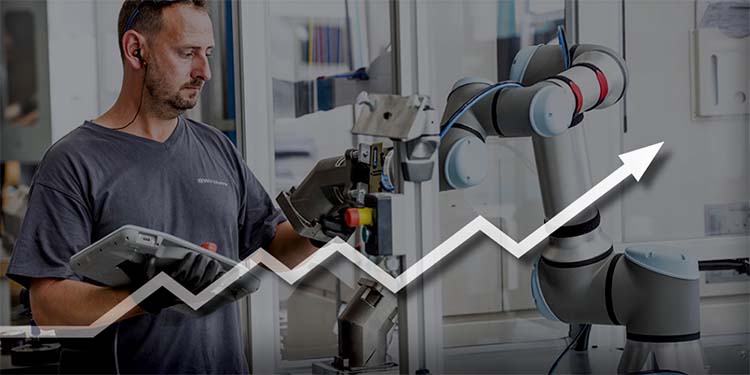
By: Flexxbotics September 2021
Maximizing Your Robot Investment
Through Robot Utilization
Collaborative robots can help small and medium businesses to automate their production. The goal of such an investment has always been to get the fastest return-on-investment possible (ROI). We have seen companies get 6-18 months ROI with Universal Robots. Unfortunately, many companies don’t have the production to get such an ROI. They need to use the robot at many different applications to see the same return. One of the main indicators for this is robot utilization. But what is robot utilization, and how can it affect the return on your investment in collaborative robots?
What Is Robot Utilization And Why Does It Matter?
To understand more about making the most of your robot, let’s talk about three important metrics to consider. Below is a brief description:
Robot Capacity:
The maximum amount of time a robot can run. For example, if you have two eight-hour shifts, the robot has a total capacity of 16 hours.
Robot Utilization:
The amount of time a robot is running vs. the robot’s capacity. For example, if a robot runs 8 hours with a total capacity of 16 hours, it has a utilization rate of 50%.
Robot Efficiency:
The part output vs. time vs. yield. For example, if a robot makes 900 parts in 8 hours and 800 of those parts are accepted, it has an efficiency of 100 parts per hour.
There are several ways to compute the robot utilization rate, but the easiest way is to divide the robot running time by the robot’s capacity.
Robot Utilization Rate = Robot Running Time / Robot Capacity.
The utilization rate is the one to consider that will first affect your ROI. Of course, leaving a robot idle is not ideal. You can adjust certain factors in your workflow to use your robot to its maximum capacity.
Factors That Affect Robot Utilization
To speed up your ROI time, you need to understand the factors that will affect your
robot utilization.
Production Needs
Automating a task that you are not doing full time in your production will be hard to justify. Sometimes, to increase the quality and consistency of the work, a robot could make sense. But for the sake of productivity, the robot use won’t be maximized right off the bat. Therefore, selecting the application offering the best utilization rate is important to start your automation journey.
If your robot is tending a machine, you need to consider the synergy between both. As the machine will perform a task, the robot will stand there idle, waiting after the part. Again, this can affect your utilization rate hence your potential ROI.
Robot Redeployment
Two main advantages of collaborative robots are their flexibility and the possibility to move them from task to task. Indeed, it is a great way to make the most of your robot, but the redeployment time needs to be considered. The time used to switch the robot between tasks affects your robot utilization rate. Remember, the faster the robot goes back to production, the quicker the return of your investment.
Planned and Unplanned Downtime
Another factor that can affect robot utilization is planned downtime. Planned downtime generally includes scheduled maintenance and reprogramming of the robot cell. It is difficult to eliminate this kind of downtime, but make sure you are prepared for it when the time comes. It is also important to make sure that your employees perform the planned downtime task during the allocated or specified time.
Unplanned downtime can be mechanical problems or programming issues. You can avoid them by making sure the robot undergoes regular maintenance and has an optimized program. In addition, training your operators on how to operate and program them properly helps lessen random stops.
Improving Robot Utilization To Increase Your ROI
As you now understand, increasing your robot utilization will increase your return on investment speed. Here are some ways to improve the previous factors that affect your robot utilization:
- Select applications that are running full time already or that can run even longer. If you don’t have such applications, consider using your robot for different tasks by redeploying it – but do it efficiently!
- Consider having the robot run during breaks, overtime after the production day, or even overnight in a lights-out production. For that, you’ll need to consider more technologies and extra development time, but it will be worth it.
- Minimize the time for your robot redeployment. To do that, you need to systemize your deployment process, train your team and use easy and fast deployment systems like Flexxbotics’ products.
- Keep your scheduled maintenance on track and be efficient doing them.
- Take note of all problems of the robot cell as they occur, either mechanical or software. Then, adjust and optimize your robot cell at each of those events. You’ll then end up with a fully optimized cell that will run as efficiently as possible.
You see, to maximize your return on investment, you need your robot to run smoothly as often and as long as possible. This will help you benefit from your automation investment and increase your utilization rate. As explained above, in many circumstances, you’ll need to redeploy your robots. You can use systems and tools that are easy to use and fast to implement to increase your productivity, which in turn translates to a faster ROI. Flexxbotics’ mission is to make sure that every robot works to its maximum capacity and meets its intended ROI.
